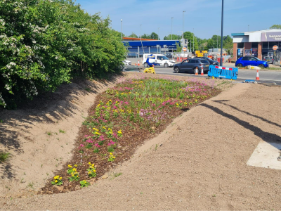
An innovative sustainable drainage system (SuDS) is being implemented as part of the A452 Myton/Queensway roundabouts improvement scheme.
The initiative aims to dramatically reduce the risk of flooding in the Princes Drive area over the next 30 years.
Warwickshire County Council (WCC), in collaboration with Warwick District Council, is taking advantage of the wide verge space to implement SuDS. Swales and rain gardens are being introduced around both roundabouts - an engineering-first for the county.
A ‘rain garden’ is a type of landscaping that helps prevent flooding by capturing and absorbing rainwater. The rain gardens are constructed with porous membranes, gravel layers, and robust perennial plants designed to withstand both saturated and dry conditions. By slowing down the flow of surface water and allowing it to infiltrate into the ground, rain gardens reduce the risk of flooding and improve water quality.
Swales, the shallow, vegetated channels designed to manage stormwater are being installed around the perimeter of the roundabouts and along the carriageway verges. Designed with staggered dams and specialist kerbing, they help capture and slow the flow of rainwater, allowing runoff to be absorbed and filtered before it reaches overflow systems.
This forward-thinking approach follows drainage modelling that indicated a standard drainage system would leave the area highly vulnerable to surface water flooding in the coming decades. This is the first rain garden scheme installed by WCC, marking a significant step forward in climate-resilient infrastructure and long-term flood defence for the region.
Councillor Rob Howard, Leader, Warwickshire County Council said:
"We’re proud to deliver the Council’s first ever rain garden as part of the A452 Myton/Queensway roundabouts improvement scheme. This sustainable drainage system not only enhances the visual landscape, but plays a vital role in managing surface water, reducing flood risk, and improving local biodiversity.
It’s a great example of how we’re investing in more resilient, future-proof infrastructure that supports both our communities and the environment.”